Camouflage and Markings of the Messerschmitt Me 109
A reprint from my editorial archives is this camouflage feature by Mr Rick Kent, originally posted at the pages of IPMS Stockholm - Ed.
I believe some readers will raise their eyebrows seeing that I have captioned the most popular German fighter ever Me 109 rather than Bf 109. Well, there is an explanation. During my work as the librarian of the RAF Museum I studied several copies of German books - rather like a smaller version of the British Janes All the Worlds' Aircraft - dated from 1937 to 1939. Now these, in Nazi Germany, must have had official approval to be published and all of them refer to the 108, 109, and 110 as "Me" rather than "Bf", so my sources for using the Me designation are contemporary German ones. I shall leave it to the reader if he/she wishes to use "Bf" as most other references do.
As most modellers will know, the Me 109 featured a vast array of standard and non-standard finished throughout it's service life. Luftwaffe units were allowed much more initiative than for example RAF in producing their own schemes to suit local conditions and were not rigidly controlled from above in this respect. Here is a collection of twelve examples - many on a non-standard side - that I hope readers will find interesting.
Here is a Me 109E-3 in the original camouflage scheme used up until after the invasion of Poland, namely a splinter pattern of RLM70 Schwarzgrün and RLM71 Dunkelgrün on top and coming right down the fuselage sides, with RLM65 Hellblau underneath. The identification number and II.Gruppe marking are white as is the spinner, all indicating the 4.Staffel.
The yellow nose paint was first introduced on 109's during the Polish campaign as a recognition marking to avoid "friendly" fire from the Wehrmacht when operating on ground strafing missions; I have read that the Luftwaffe lost more 109's this way in Poland than were actually lost in combat, and hence the yellow became the much used ident colour in future offensive campaigns. The shield with seagull badge of II.Gruppe JG 77 was on both sides, but the "Grim Reaper" badge of 4.Staffel was only on the left side. Note the small size of the early thin style of cross and original position of the swastika.
In addition to the oil and fuel triangles this aircraft also shows the red cross on white square marking on the rear fuselage hatch where the first-aid medical kit was stowed.
This 109E-1 of JG.53 is from that period between the invasion of Poland and France when the German fighter units were experimenting with alternative camouflage schemes to the original RLM70/71 upper surface colours which had proved too dark in the Polish campaign - hence it has a very unusual splinter pattern of RLM70 Schwarzgrün, RLM02 Grau and RLM62 Grün on top with the usual early wartime RLM65 Hellblau underneath. The fuselage cross is still the early narrow outlined type and the swastika is in the original position over the fin/rudder hinge line.
Note that there is one victory symbol on the fin, just above the forward tailplane. The "Pik-As" badge of JG.53 on the nose is well-known. What seems a little unusual is that the aircraft carries the markings of the Major beim Stab and yet the pilot is only of Oberleutnant rank; perhaps it was not his regular aircraft? The triangle markings in red and yellow are, of course, the usual ones for oil and fuel filling points, and also as a general rule with all German fighters the trim-tabs on the control surfaces are painted red as a warning to prevent accidental damage.
Here is a 109E-4 of the famous Richthofen Geschwader, JG2, at the time of the Battle of Britain. The basic camouflage is that adopted as standard by the time of the invasion of France, namely a splinter pattern of RLM71 Dunkelgrün and RLM02 Grau on top with RLM65 Hellblau sides and underneath.
During the course of the Battles of France and Britain the fighter Geschwarden increasingly took to toning-down the side colouring with various patterns and colours of mottling and stippling, each devised by the individual units. The type of stippled painting with RLM71 as seen on this aircraft was unique to JG2 and was applied by hand using either short-haired brushes or padded rags, unlike the more usual sprayed-on mottling used by other units. The effect was to give a much finer spotting of paint than the blotches achieved by spraying. Note how the stippling has been painted over the outer parts of the original thick white border of the cross, but that the black edging remains.
The swastika is now moved to the more familiar later position on the fin entirely. The propeller spinner is black and the blades RLM70 Schwarzgrün. The famous red "R" on silver shield of the Richthofen Geschwader is below the windshield and the HORRIDO badge of 3.Staffel on the nose; both of these markings are on both sides of the fuselage. The yellow colour of the identification number also indicates 3.Staffel.
This 109E-3 has an interesting story attached to the markings. Major von Cramon-Taubadel was married to a Jewish wife, a fact which came to the attention of Hermann Goering during the Battle of France. As a result he ordered that the whole of JG 53 must remove their famous Ace of Spades badge and paint a red band around the noses of their aircraft as a mark of shame. In the Autumn of 1940 von Cramon-Taubadel was removed as Geschwader Kommodore and Goering told them they could reinstate their "Pik-As" badge; this they did but at the same time, as a mark of protest, all the pilots of JG 53 had the Swastikas painted over on their aircraft. Thus it is easy to recognise JG 53 109's late in the Battle of Britain as they have no Swastikas on them.
This profile shows Major von Cramon-Taubadel's aircraft with the red band marking when the Geschwader were operating from Cherbourg and the Channel Islands during the Battle of Britain. The basic camouflage is a splinter pattern of RLM70 Schwarzgrün and RLM02 Grau over RLM65 Hellblau sides and underneath with RLM02 Grau mottling on the sides. The cross, although of the larger size, still has the thinner white edges.
The usual oil, fuel, and first-aid kit markings are all present. The propeller spinner and Kommodore's markings are in black, the latter outlined white. Prop blades were RLM70.
I have decided to include this 109E-4 of 2./JG 52 to illustrate the use of large areas of yellow paint introduced in the Autumn of 1940 in the later stages of the Battle of Britain. Some authors I have read believe that this was in somewhat premature anticipation of the German invasion of England which, of course, never took place; I have my doubts about that and think it far more likely that it was for purposes of quick aerial recognition in those hectic daily battles over southern England. In this instance the yellow is in the most usual places on the nose and rudder, though there were many variations including yellow on the wingtips, tailplanes and elevators, and ailerons.
The yellow nose includes the spinner as well, with RLM70 Schwarzgrün prop blades. The upper camouflage is in a splinter pattern of RLM71 Dunkelgrün and RLM02 Grau and the underneath and sides are in RLM65 Hellblau with RLM71 mottling over the sides. The fuselage cross is of the more common later large style with wide white outlines and the First-Aid red cross is in a white disc over the black of the cross. The oil and fuel triangles appear as normal. The individual number is in the black colour of 2.Staffel with a thin white outline. The badge is on both sides of the nose.
Here a Me 109F-2 on the Eastern Front not long after the initial German invasion of the USSR. The basic camouflage is of RLM02 Grau and RLM70 Schwarzgrün in a splinter pattern on top with RLM76 Lichtblau underneath and sides, the blue having a mottling of both the grey and the green over it on the sides. Yet again we have considerable use of yellow identification paint under the nose, wingtips and band around the rear fuselage.
The white serpent badge of 1.JG 3 is on both sides of the nose, and the individual number and most of the spinner are also white, the number being outlined thinly with black and part of the rear spinner also black. There are 21 kill markings on the rudder, 20 in black and one in white. As usual the propeller blades were .
The above Me 109F-4/Trop shows a fairly typical Luftwaffe desert colour scheme and markings. The basic camouflage is of RLM79 Sandgelb on top with RLM78 Himmelblau underneath. The sides are slightly mottled with RLM80 Olivgrün. The metre wide white band on the fuselage was standard on Luftwaffe aircraft operating in North Africa, Sicily, and Italy as it matched the similar marking of the Reggia Aeronautica; on this particular aircraft the wingtips are also white. However, the underside of the cowling retains the usual Luftwaffe yellow ident paint. The front of the spinner, ident number and Gruppe marking are all yellow for the 6.Staffel. The rear of the spinner is black, and prop blades RLM70 Schwarzgrün. The II/JG 3 shield is on both sides of the fuselage.
The aircraft is, of course, fitted with the tropical sand filter on the supercharger air intake.
Here we have a Me 109G-6 in the basic camouflage colours adopted originally in the later part of the Battle of Britain. These are a combination of RLM74 Graugrün and RLM75 Grauviolett on top with RLM76 Lichtblau underneath and sides. Various colours were used for mottling the sides, in this particular case a fairly heavy mottle of RLM75 sprayed over the blue in varying depths.
The spinner is black with a one third segment of white and the later type of JG 1 badge (a figure 1 made into a stylised eagle) is on the nose in red and white. The fuselage cross has no black edges, nor does the swastika, but the individual number and Gruppe bar are outlined thinly with black. The red band marking of JG 1 is on the rear fuselage - it should be noted that the width of this band varied from aircraft to aircraft.
Lastly it should be noted that the fuel octane triangle on the G model was moved back to a similar position as on the 109E, high up on the fuselage side rather than over the wing root.'
After the initial release of this article, Scott Fraser of Tally Ho Model Products pointed out to me: "The badge you have drawn for JG 1 has the wrong colours. The disk is blue, the numeral red, and the wings are yellow. Sadly, this is not an uncommon mistake. You're in good company..."
Every reference I have ever seen has described the colours of that badge as I did them here in red and white, but I have always found Tally Ho Products to be quite excellent and Scott Fraser does say that many others are wrong about it, so I really don't know what to do in the circumstances. Anyway, now that I have pointed out the matter, modellers can make up their own minds.
This next 109G is the -6/R-6 version with the extra cannon under the wings. The camouflage consists of a pattern of RLM74 Graugrün and RLM75 Grauviolett on top with RLM76 Lichtblau underneath and sides. The sides are mottled with RLM75 apart from the large patch of RLM02 Grau below and behind the cockpit. The spinner is black with a white spiral, the individual number "11" is white for the 7.Staffel, whilst the III.Gruppe bar is black.
The broad white band around the fuselage is that used by a number of Geschwadern as a Reich Defence marking before they adopted the different coloured bands for individual Geschwadern. Once again neither the fuselage cross nor the swastika have any black outline. The JG 3 "Udet" shield is in red and white on both sides of the nose as is the large shooting-star gruppe marking; the shape of this star seems to have varied slightly from aircraft to aircraft, probably indicating that it was painted on by hand rather than using a stencil.
Here I have drawn a 109G-6 in a fairly complicated winter camouflage scheme. It has originally been painted in the usual RLM74 Graugrün and RLM75 Grauviolett on top with RLM76 Lichtblau underneath and sides with RLM75 mottling on the sides. This has then had a very liberal application of winter white painted over the top of most of the aircraft, including the cross and swastika, though the underneath remains RLM76 and the canopy framing remains RLM74. The yellow rudder recognition marking is also untouched by the white.
The red aircraft number "29" is thinly outlined with white. The spinner is black with a one third white segment and the propeller blades are the usual RLM70 Schwarzgrün. The underwing crosses are complete with black edging.
This 109K shows the brown and green style of camouflaging over various undersurface colours used by many Luftwaffe fighters closer to the end of the war; in a way it shows graphically the reversal of fortunes since 1940 when the RAF used such colours whilst German aircraft were using shades of grey.
The actual shades on this aircraft are supposed to be RLM81 Braunviolett and RLM82 Dunkelgrün camouflage pattern and mottling on top and sides with the lower fuselage in RLM84 (?) sky-green and undersides of the wings and tailplane in RLM76 Lichtblau. The designation RLM84 is speculatory; some newest research suggests that this sky-type colour could have been the RLM99 surface primer. It should also be remembered that towards the end of the war the Germans were running out of official paint stocks and many aircraft were painted with whatever paints were available and, thus, colours often varied quite a lot from the official specifications.
The spinner of the aircraft is black with a wide white spiral; underwing crosses in plain thick black outline only; upperwing crosses in thin white outline only; fuselage cross in RLM82 with thick white edges; and black swastika with thin white outline. The Gruppen Adjutant's chevron and III.Gruppe bar are black with thin white outline, whilst the wide green Reich Defence band represents JG 27.
The last of this set of 109's is another K model. This one is in the other type of camouflaging most often seen near to the end of the war, with upper surfaces in RLM75 Grauviolett and RLM82 Dunkelgrün with RLM76 Lichtblau underneath. The crosses and swastika are all of the same type as the previous 109K, and the spinner is again black with white spiral.
The III.Gruppe bar is black with thin white edge and the ident number 4 in yellow for 11.Staffel. The name "Ingeborg" is in white longhand script below the cockpit on the left side only.
Rick Kent is a modeller, IPMS:er and a productive aviation artist. His speciality are computer-generated aircraft profiles.
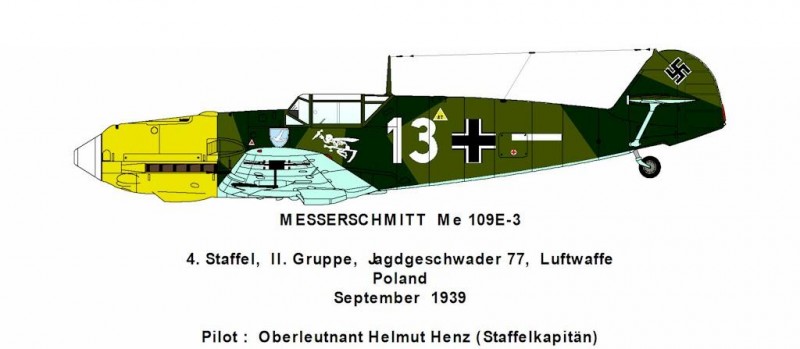
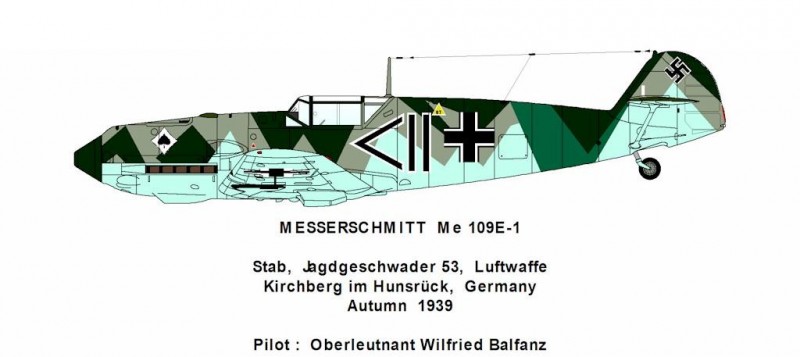
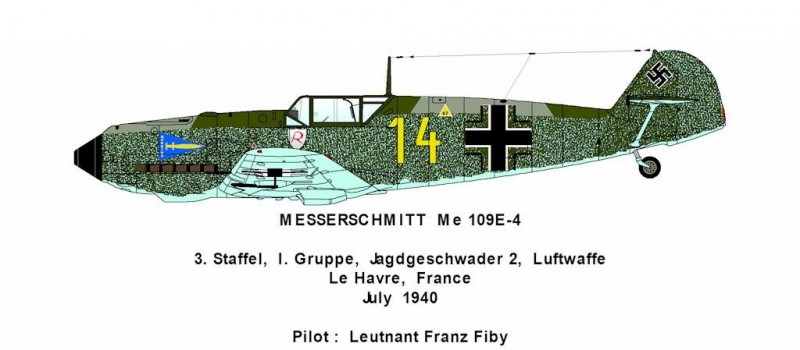
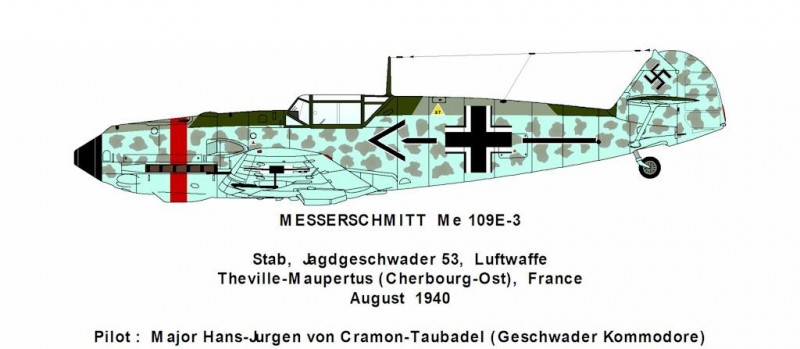
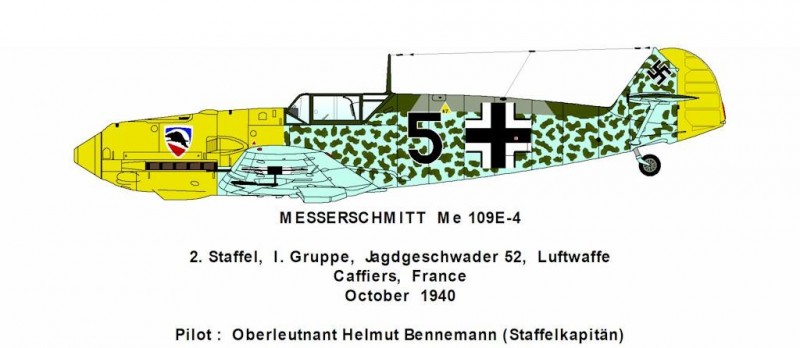

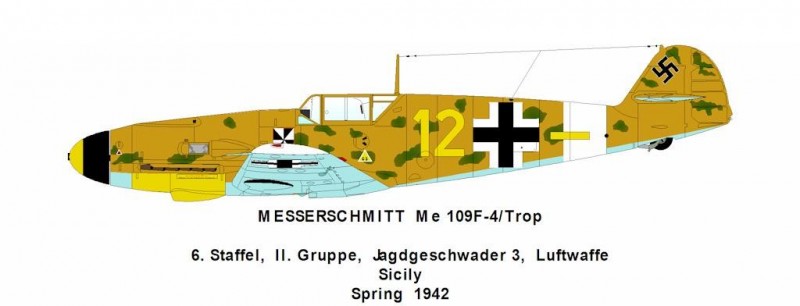
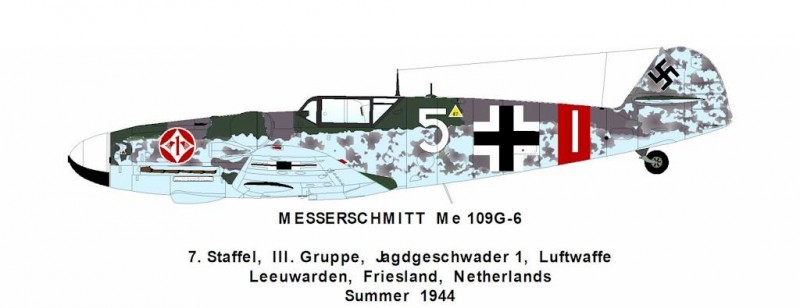
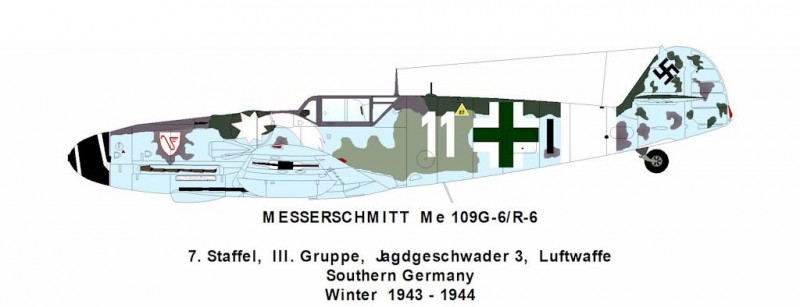
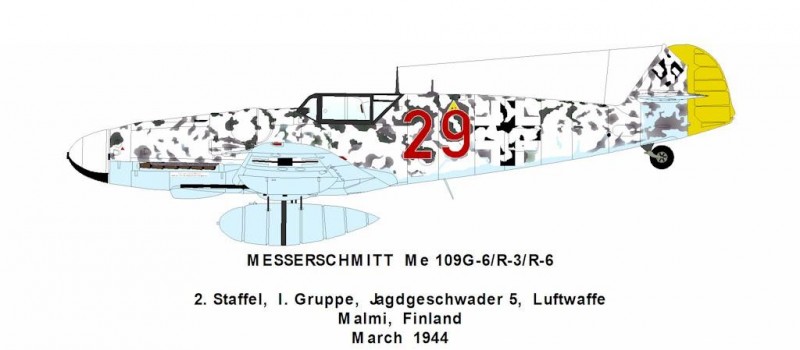
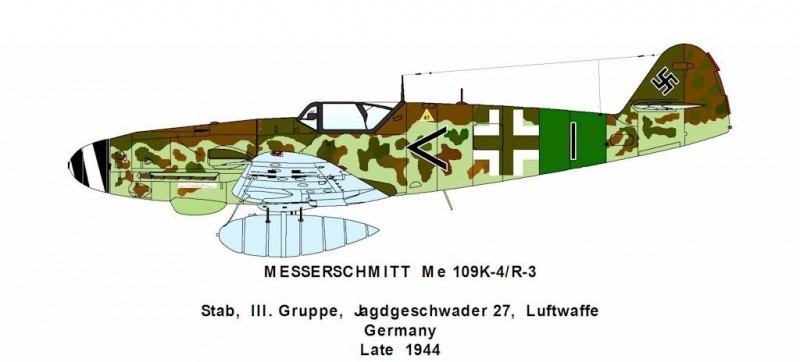
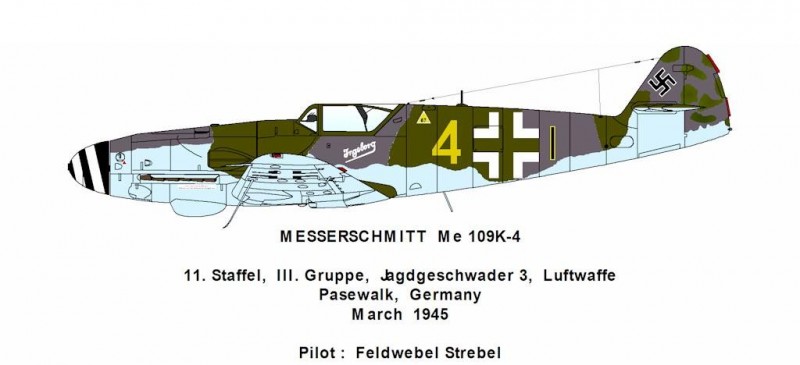
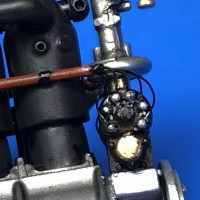

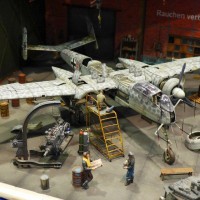
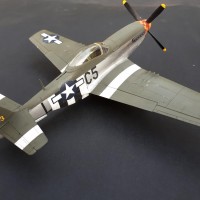
Obviously this is another addition to today's "Attack of 109′s" here at iModeler... great idea IMHO.
I've not seen many of those schemes before, Martin...thanks for the color plates. Very interesting.
Great to share some of those schemes with us. I particularly like the 109E-1 from JG53, which is very unusual.
check out u tube film of vw beetle in adolf galland colours love these camo designs
What we're striving for is the smoky / cloudy effect we see in so many of the period films and photos, but so often represented by modellers and diecast manufacturers as crude dappling or blobs of colour.